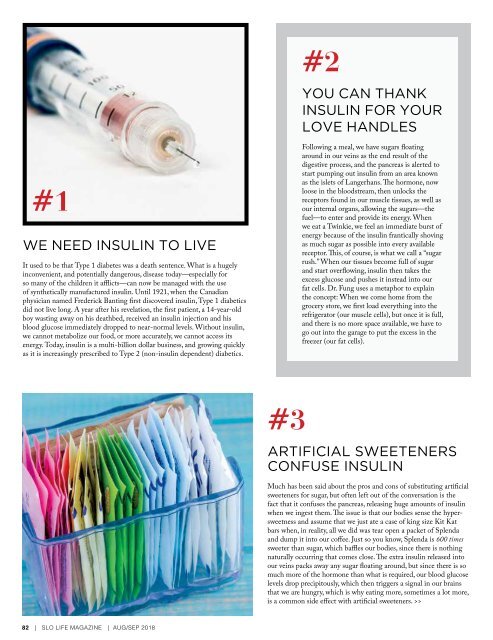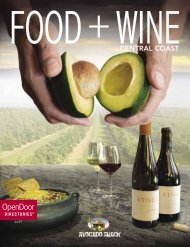SLO LIFE Magazine Aug/Sep 2018
Create successful ePaper yourself
Turn your PDF publications into a flip-book with our unique Google optimized e-Paper software.
#2<br />
YOU CAN THANK<br />
INSULIN FOR YOUR<br />
LOVE HANDLES<br />
#1<br />
WE NEED INSULIN TO LIVE<br />
It used to be that Type 1 diabetes was a death sentence. What is a hugely<br />
inconvenient, and potentially dangerous, disease today—especially for<br />
so many of the children it afflicts—can now be managed with the use<br />
of synthetically manufactured insulin. Until 1921, when the Canadian<br />
physician named Frederick Banting first discovered insulin, Type 1 diabetics<br />
did not live long. A year after his revelation, the first patient, a 14-year-old<br />
boy wasting away on his deathbed, received an insulin injection and his<br />
blood glucose immediately dropped to near-normal levels. Without insulin,<br />
we cannot metabolize our food, or more accurately, we cannot access its<br />
energy. Today, insulin is a multi-billion dollar business, and growing quickly<br />
as it is increasingly prescribed to Type 2 (non-insulin dependent) diabetics.<br />
Following a meal, we have sugars floating<br />
around in our veins as the end result of the<br />
digestive process, and the pancreas is alerted to<br />
start pumping out insulin from an area known<br />
as the islets of Langerhans. The hormone, now<br />
loose in the bloodstream, then unlocks the<br />
receptors found in our muscle tissues, as well as<br />
our internal organs, allowing the sugars—the<br />
fuel—to enter and provide its energy. When<br />
we eat a Twinkie, we feel an immediate burst of<br />
energy because of the insulin frantically shoving<br />
as much sugar as possible into every available<br />
receptor. This, of course, is what we call a “sugar<br />
rush.” When our tissues become full of sugar<br />
and start overflowing, insulin then takes the<br />
excess glucose and pushes it instead into our<br />
fat cells. Dr. Fung uses a metaphor to explain<br />
the concept: When we come home from the<br />
grocery store, we first load everything into the<br />
refrigerator (our muscle cells), but once it is full,<br />
and there is no more space available, we have to<br />
go out into the garage to put the excess in the<br />
freezer (our fat cells).<br />
#3<br />
ARTIFICIAL SWEETENERS<br />
CONFUSE INSULIN<br />
Much has been said about the pros and cons of substituting artificial<br />
sweeteners for sugar, but often left out of the conversation is the<br />
fact that it confuses the pancreas, releasing huge amounts of insulin<br />
when we ingest them. The issue is that our bodies sense the hypersweetness<br />
and assume that we just ate a case of king size Kit Kat<br />
bars when, in reality, all we did was tear open a packet of Splenda<br />
and dump it into our coffee. Just so you know, Splenda is 600 times<br />
sweeter than sugar, which baffles our bodies, since there is nothing<br />
naturally occurring that comes close. The extra insulin released into<br />
our veins packs away any sugar floating around, but since there is so<br />
much more of the hormone than what is required, our blood glucose<br />
levels drop precipitously, which then triggers a signal in our brains<br />
that we are hungry, which is why eating more, sometimes a lot more,<br />
is a common side effect with artificial sweeteners. >><br />
82 | <strong>SLO</strong> <strong>LIFE</strong> MAGAZINE | AUG/SEP <strong>2018</strong>


















